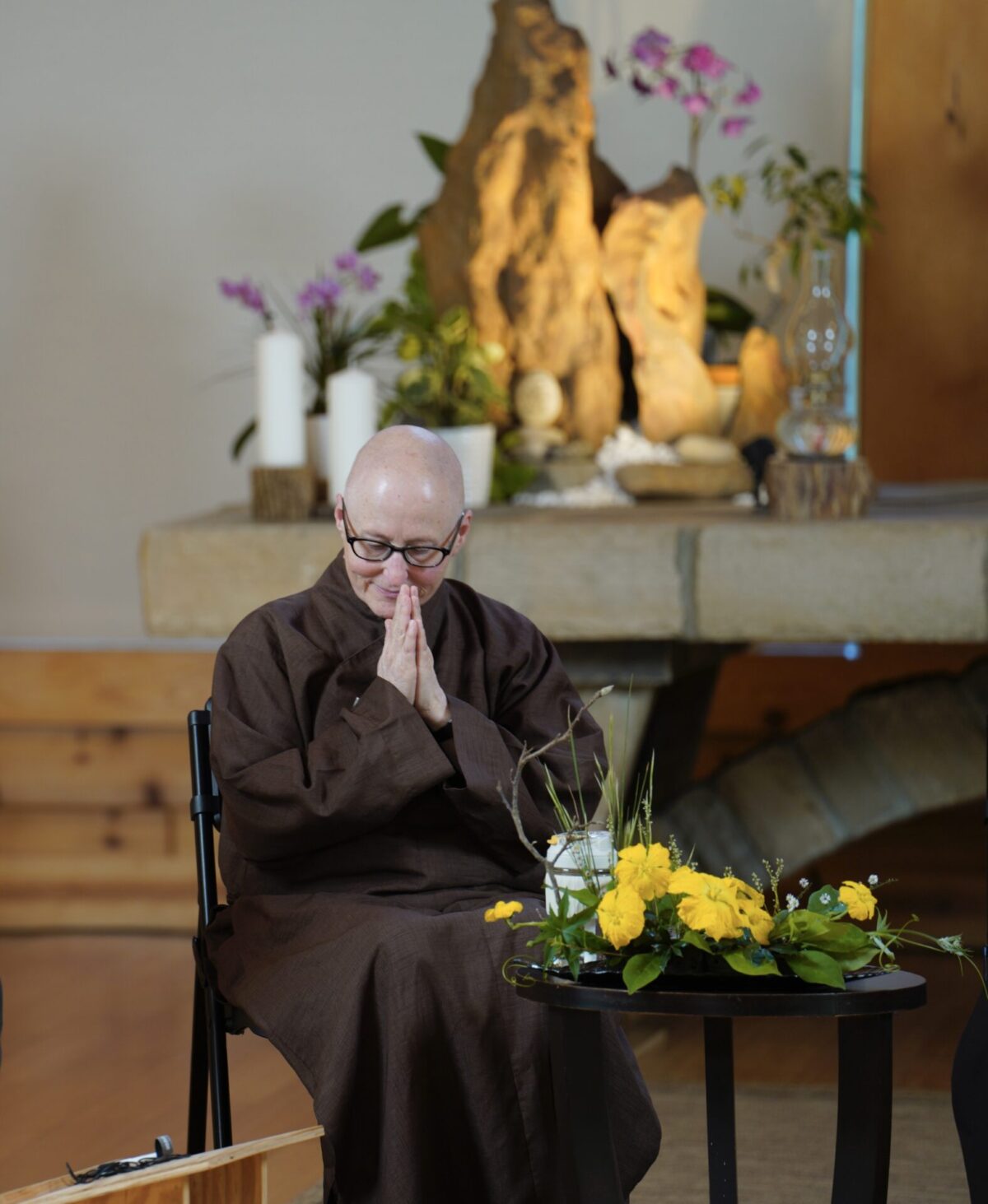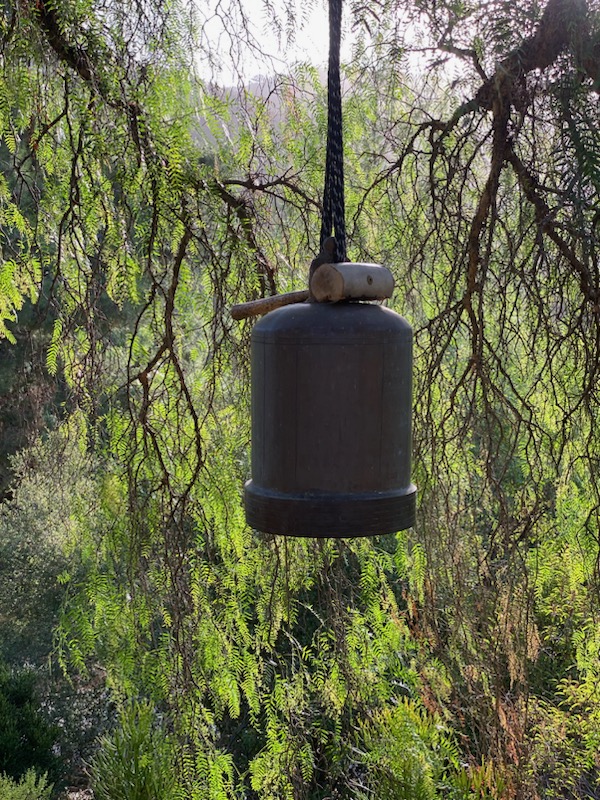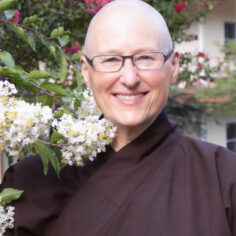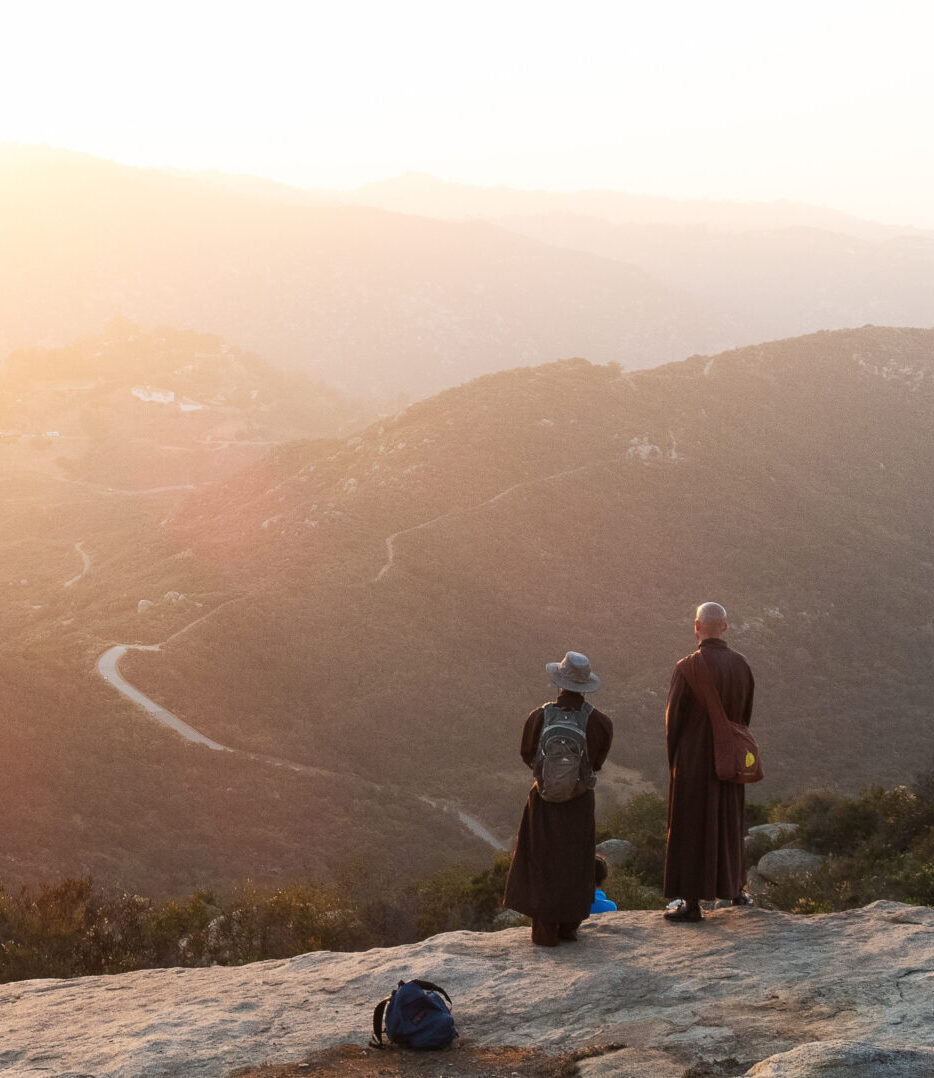By Sister Trì Nghiêm on
Sister Chân Trì Nghiêm explains how Plum Village practice centers provide much-needed refuge and hope in today’s troubled times.
At a time when the world seems to be racing at breakneck speed toward planetary destruction, when we know what to do to protect conditions for life on Earth but fail to do it, when sources of reliable information are increasingly difficult to find,
By Sister Trì Nghiêm on
Sister Chân Trì Nghiêm explains how Plum Village practice centers provide much-needed refuge and hope in today’s troubled times.
At a time when the world seems to be racing at breakneck speed toward planetary destruction, when we know what to do to protect conditions for life on Earth but fail to do it, when sources of reliable information are increasingly difficult to find, when governments favor the wealthy and powerful over the poor and disenfranchised, what role can Buddhist monasteries—specifically in the West—possibly play?
In an age of increasing generative artificial intelligence (AI) and disinformation, when the boundaries between real and fabricated are increasingly blurred—a post-truth era—Western Buddhist monasticism may appear anachronistic, a romanticized relic of a more optimistic and spiritually inclined age.
But against this backdrop, practicing in a meditation and mindfulness practice center may be the most sane and meaningful thing to do. Practicing mindfulness with others can counter the growing anxiety, helplessness, and despair we feel within us as we look at a world literally and figuratively on fire. For an increasing number of young people looking to the future and dissatisfied with the prospects on offer, turning inward to find solutions to our global problems has become a matter of urgency.

Growing interest among young, well-educated, and talented people in practicing in one of our community’s many practice centers as well as in ordaining as monks and nuns is perhaps both a symptom of the times and a hopeful sign for the future.
For those who have lost faith in modern political, economic, and social systems, practicing mindfulness is a revolutionary act. Dedicating one’s life to the cause of mindful healing requires determination and a warrior spirit.
Life in a monastery, whether for a retreat or for a lifetime, provides an alternative to the pull of instant gratification, relief from the quest for a stream of never-ending dopamine hits, an invitation to choose a life with awareness and presence over one of virtual reality, and an opportunity to heal our addiction to digital devices and social media. In the still, contemplative environment of a Zen community, lay and monastic practitioners learn to see their sources of suffering with clear eyes and develop the capacity to transform discrimination, injustice, and inequity, in themselves and in the world.

If you ask people who come to practice in one of our meditation and mindfulness practice centers around the world why they come and what they appreciate most about it, their answers are surprisingly similar.
They mention finding a place of refuge here, a peaceful oasis where they can resource themselves and recharge their batteries. They come to have a break from the stress of their daily lives, from their families or high-powered jobs and draining responsibilities. They come to immerse themselves in an environment where everyone is practicing the same thing, where everyone is trying to strengthen their mindfulness and touch more peace and happiness within themselves.
Being surrounded by like-minded practitioners is supportive for practice. Activists, business leaders, therapists, health professionals, and teachers come to heal their burnout, to regain strength, hope, and the energy to keep doing what they do.
They come looking for support on their own path of healing and transformation. They say it’s important to know there is a place where they can take refuge, where they can experience community, kindness, and care, where they can experience the joy of being together, the joy of stopping, and the healing and liberation that comes from being rather than constantly doing.
One young man, a recent retreatant at Magnolia Grove Monastery in Mississippi, US, said this about his experience at the practice center: “My resting heart rate dropped ten bpm on the day I arrived. Just being in this environment is beneficial. It’s hard to put it into words; we have to experience it in the body to know what it feels like to be in such a place.”
Some visitors find it difficult to express how their experience has affected them, though they’ll say it has something to do with a sense of community, with connection, and with a feeling of belonging. They say they not only discover more about themselves, but find a spiritual family and forge deep connections—not only human connections, but connections with trees, birds, woods, sun, and moon.
By going inward, they touch the earth, their animal, vegetal, and mineral ancestors, their blood and adopted human ancestors, and their cultural and spiritual ancestors. A residential monastery provides a framework and refuge where lay practitioners can experience essential connections that give their lives meaning. Getting in touch with their spiritual and cultural roots enables deep healing and transformation to take place.
The monastics who live and practice twenty-four hours a day, every day of the week, year after year, decade after decade, are the glue that holds it all together and makes it all possible. Monastics safeguard the transmission of the teachings and practices in an unbroken stream from teacher to disciple going back more than two millennia to the time of the Buddha and before. In the tradition of context- and kinship-rich societies, transmission of wisdom in Buddhist monasticism is both oral and nonverbal. We listen to Dharma talks and classes about the precepts and Mindfulness Trainings given by senior monastics. We share about the teachings and our practice in sharing circles. We chant the sutras. But we also learn by observing the way others walk, talk, eat, drink, stand up and sit down, come in and go out.
Our teacher taught by walking the talk. To watch Thầy walk, open a door, or drink tea was to witness a Dharma talk. This is how we learn: by observing and doing our best to emulate and embody the teachings.
Transmission of Buddhist wisdom is not an intellectual or literary pursuit. It has always been an embodied practice, modeled and handed down to the next generation. The mindfulness and concentration generated in this practice is what leads to insight, to liberation from our wrong views and ways of thinking, which are the cause of so much of our suffering. It is in the monastery that we learn how to apply the teachings in all aspects of our daily life and in our manifold relationships.
The most important thing about our practice centers, practitioners say, is Sangha. Community. The collective energy of mindfulness generated in a community that lives in harmony and awareness is palpable, and this is what nourishes and sustains those who come.
The embracing support of the community helps practitioners maintain and deepen their practice. Over the years—or even in a one-week retreat—they experience healing, transformation, and an increasing capacity for joy, peace, and happiness. Visitors lean on the monastics to do this—nuns and monks are the custodians of both the practice and the tradition.
Monastic practitioners learn the art of living simply and happily in community with few possessions and desires. They observe the Mindfulness Trainings and hundreds of precepts and fine manners. They practice stopping and looking deeply to understand their own mind. They practice impulse control and mindful consumption. They illustrate that joy and happiness in the here and now are possible. They demonstrate the art of cultivating joy and letting go of unhelpful states of mind, the art of releasing attachment to ideas and things. They learn to bring the wandering mind home to the body and to dwell happily in the present moment. They learn to take care of strong emotions and to recognize their wrong perceptions. They learn to heal themselves and their inner child. In short, they model the teachings to the best of their ability, and this is what practitioners who visit find so helpful.
The individual consciousness of each practitioner contributes to the collective consciousness of the whole community. And this is perhaps the biggest reason why our monasteries are not just an interesting alternative lifestyle but an imperative in today’s world.
If we are to have a future, let alone a hopeful future, our young people must not succumb to despair. We desperately need islands of peace where we all can take refuge in something good and true and beautiful.
To bring about change in the world, we must first change our way of thinking and being in the world. We must transform our consciousness. We must go within and do the hard work of healing and transformation.
This work takes the courage and fearlessness of a warrior, and we need an army of spiritual warriors all around the world to generate a collective awakening capable of effecting the only truly hopeful change that might support continued life on our planet.
When we awaken to the holiness of all life, when we transcend notions of good and bad, of friend and foe, when we truly grasp the reality of interbeing and stop our violent and exploitative ways and recognize the oneness of all creation, then we have hope for the future.
We hope our practice centers, with your generous and continuing support, can contribute to this global spiritual awakening for decades to come.
Sister Chân Trì Nghiêm, 30 September 2024
The Thích Nhất Hạnh Foundation is grateful to Sister Chân Trì Nghiêm for writing this beautiful article. To learn more about the foundation, and to support our precious monasteries, please visit https://thichnhathanhfoundation.org/ways-to-give.


